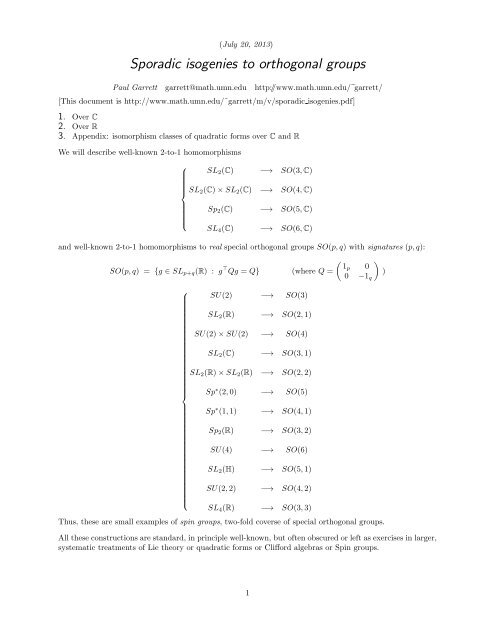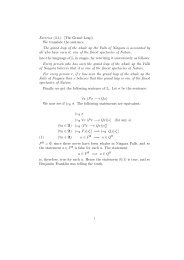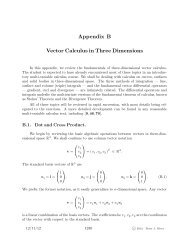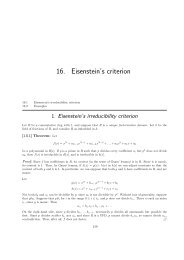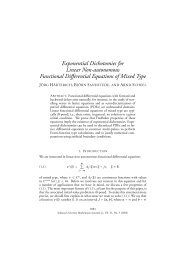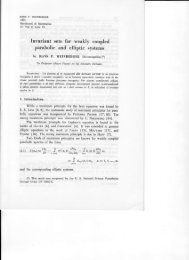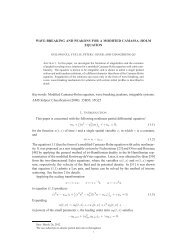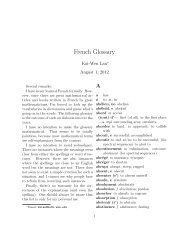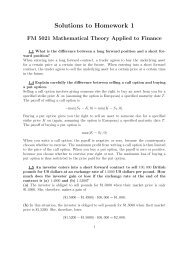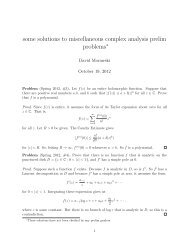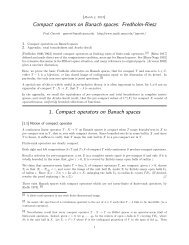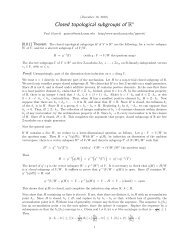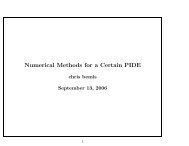Sporadic isogenies to orthogonal groups
Sporadic isogenies to orthogonal groups
Sporadic isogenies to orthogonal groups
Create successful ePaper yourself
Turn your PDF publications into a flip-book with our unique Google optimized e-Paper software.
(July 20, 2013)<br />
<strong>Sporadic</strong> <strong>isogenies</strong> <strong>to</strong> <strong>orthogonal</strong> <strong>groups</strong><br />
Paul Garrett garrett@math.umn.edu http://www.math.umn.edu/˜garrett/<br />
[This document is http://www.math.umn.edu/˜garrett/m/v/sporadic <strong>isogenies</strong>.pdf]<br />
1. Over C<br />
2. Over R<br />
3. Appendix: isomorphism classes of quadratic forms over C and R<br />
We will describe well-known 2-<strong>to</strong>-1 homomorphisms<br />
⎧<br />
SL 2 (C) −→ SO(3, C)<br />
⎪⎨ SL 2 (C) × SL 2 (C) −→ SO(4, C)<br />
⎪⎩<br />
Sp 2 (C) −→ SO(5, C)<br />
SL 4 (C) −→ SO(6, C)<br />
and well-known 2-<strong>to</strong>-1 homomorphisms <strong>to</strong> real special <strong>orthogonal</strong> <strong>groups</strong> SO(p, q) with signatures (p, q):<br />
SO(p, q) = {g ∈ SL p+q (R) : g ⊤ Qg = Q} (where Q =<br />
⎧<br />
SU(2) −→ SO(3)<br />
SL 2 (R) −→ SO(2, 1)<br />
SU(2) × SU(2) −→ SO(4)<br />
SL 2 (C) −→ SO(3, 1)<br />
SL 2 (R) × SL 2 (R) −→ SO(2, 2)<br />
( )<br />
1p 0<br />
)<br />
0 −1 q<br />
⎪⎨<br />
Sp ∗ (2, 0) −→ SO(5)<br />
⎪⎩<br />
Sp ∗ (1, 1) −→ SO(4, 1)<br />
Sp 2 (R) −→ SO(3, 2)<br />
SU(4) −→ SO(6)<br />
SL 2 (H) −→ SO(5, 1)<br />
SU(2, 2) −→ SO(4, 2)<br />
SL 4 (R) −→ SO(3, 3)<br />
Thus, these are small examples of spin <strong>groups</strong>, two-fold coverse of special <strong>orthogonal</strong> <strong>groups</strong>.<br />
All these constructions are standard, in principle well-known, but often obscured or left as exercises in larger,<br />
systematic treatments of Lie theory or quadratic forms or Clifford algebras or Spin <strong>groups</strong>.<br />
1
Paul Garrett: <strong>Sporadic</strong> <strong>isogenies</strong> <strong>to</strong> <strong>orthogonal</strong> <strong>groups</strong> (July 20, 2013)<br />
1. Over C<br />
[1.1] SL 2 (C) → SO(3, C) The space V of 2-by-2 complex matrices with trace 0, has symmetric bilinear<br />
form 〈x, y〉 = tr(xy). The action of SL 2 (C) on V by g · x = gxg −1 preserves 〈, 〉:<br />
〈g · x, g · y〉 = tr(gxg −1 · gyg −1 ) = tr(g · xy · g −1 ) = tr(xy) = 〈x, y〉<br />
An <strong>orthogonal</strong> basis is (<br />
1 0<br />
0 −1<br />
) (<br />
0 1<br />
1 0<br />
) (<br />
0<br />
)<br />
1<br />
−1 0<br />
with 〈, 〉 values 2, 2, −2, demonstrating non-degeneracy. Thus, SL 2 (C) maps <strong>to</strong> a copy of SO(3, C). The<br />
kernel is just {±1}.<br />
[1.2] SL 2 (C) × SL 2 (C) → SO(4, C) Let V = M 2 (C) be 2-by-2 complex matrices, with (g, h) ∈<br />
SL 2 (C) × SL 2 (C) acting by (g, h) · x = gxh −1 . Give V the bilinear form<br />
( )<br />
〈x, y〉 = tr(x · wy ⊤ w −1 0 −1<br />
) (where w = )<br />
1 0<br />
It is symmetric because trace is invariant under transpose, and because w −1 = −w. For g ∈ SL 2 (C),<br />
g −1 = wg ⊤ w −1 , and the pairing is invariant under the group action:<br />
tr(gxh −1 · w(gyh −1 ) ⊤ w −1 ) = tr(gxh −1 · w(h −1 ) ⊤ w −1 · wy ⊤ w −1 · wg ⊤ w −1 )<br />
= tr(gxh −1 · h · wy ⊤ w −1 · g −1 ) = tr(g · xwy ⊤ w −1 · g −1 ) = tr(xwy ⊤ w −1 )<br />
Computing<br />
( ) ( )<br />
a b a<br />
′<br />
b<br />
〈 ,<br />
′ ( ( ) ( )<br />
a b d<br />
′<br />
−b<br />
c d c ′ d ′ 〉 = tr<br />
′ ) ( )<br />
ad<br />
c d −c ′ a ′ = tr<br />
′ − bc ′ ∗<br />
∗ da ′ − cb ′<br />
an <strong>orthogonal</strong> basis is readily found: for example, [1]<br />
(<br />
1<br />
)<br />
0<br />
(<br />
1 0<br />
0 1 0 −1<br />
) (<br />
0 1<br />
−1 0<br />
) (<br />
0<br />
)<br />
1<br />
1 0<br />
= ad ′ − bc ′ − cb ′ + da ′<br />
with 〈, 〉 values 2, −2, 2, −2, demonstrating non-degeneracy.<br />
SO(4, C).<br />
Thus, SL 2 (C) × SL 2 (C) maps <strong>to</strong> a copy of<br />
[1.3] Sp 2 (C) → SO(5, C) The symplectic group [2] is<br />
⎛<br />
⎞<br />
0 0 −1 0<br />
Sp 2 (C) = {g ∈ GL 4 (C) : g ⊤ ⎜ 0 0 0 −1 ⎟<br />
Jg = J} (with J = ⎝<br />
⎠)<br />
1 0 0 0<br />
0 1 0 0<br />
[1]<br />
One can also observe from this expression that the bilinear form is a sum of two hyperbolic planes, thus giving<br />
signature (2, 2) without further computation.<br />
[2]<br />
In some conventions, the subscript is made <strong>to</strong> be the size, so what we call Sp 2 here might be called Sp 4 elsewhere.<br />
2
Paul Garrett: <strong>Sporadic</strong> <strong>isogenies</strong> <strong>to</strong> <strong>orthogonal</strong> <strong>groups</strong> (July 20, 2013)<br />
Write g σ = Jg ⊤ J −1 , so the condition can be rewritten as g σ g = 1 2 . The C-vec<strong>to</strong>rspace V will be a subspace<br />
of the space M 4 (C) of 4-by-4 complex matrices. Let 〈x, y〉 = tr(xy) on M 4 (C). Let Sp 2 (C) act on M 4 (C) by<br />
g · x = gxg σ . This action respects 〈, 〉:<br />
〈g · x, g · y〉 = tr(gxg σ · gyg σ ) = tr(g · xy · g −1 ) = tr(xy) = 〈x, y〉<br />
Since 1 4 = g σ g = g · 1 4 · g σ , the action has fixed-point 1 4 , and the subspace<br />
V = {x ∈ M 4 (C) : x σ = x and 〈x, 1 4 〉 = 0}<br />
is stable under the action. In 2-by-2 blocks, the condition x σ = x is<br />
( )<br />
a b<br />
=<br />
c d<br />
(<br />
0 −1<br />
1 0<br />
) (<br />
a b<br />
c d<br />
) ⊤ (<br />
0<br />
)<br />
1<br />
−1 0<br />
=<br />
( ) ( ) ( )<br />
0 −1 a ⊤ c ⊤ 0 1<br />
1 0 b ⊤ d ⊤ −1 0<br />
=<br />
( )<br />
d<br />
⊤<br />
−b ⊤<br />
−c ⊤ a ⊤<br />
Thus, d = a ⊤ and b, c are skew-symmetric. The condition 〈x, 1 4 〉 = 0 requires tr(a) = 0. Thus, dim C V = 5.<br />
To check that 〈, 〉 is non-degenerate on V , identify an <strong>orthogonal</strong> basis, such as<br />
⎛<br />
1 0<br />
⎜ 0<br />
⎝<br />
−1<br />
⎞<br />
⎟<br />
⎠<br />
1 0<br />
0 −1<br />
⎛<br />
0 1<br />
⎜ 1<br />
⎝<br />
0<br />
where empty positions are 0.<br />
⎞<br />
⎟<br />
⎠<br />
0 1<br />
1 0<br />
⎛<br />
0 1<br />
⎜ −1 0<br />
⎝<br />
⎞<br />
⎟<br />
⎠<br />
0 −1<br />
1 0<br />
⎛<br />
⎜<br />
⎝<br />
0 1<br />
−1 0<br />
⎞<br />
0 1<br />
−1 0 ⎟<br />
⎠<br />
⎛<br />
⎜<br />
⎝<br />
0 −1<br />
1 0<br />
⎞<br />
0 1<br />
−1 0 ⎟<br />
⎠<br />
[1.4] SL 4 (C) → SO(6, C) Let SL 4 (C) act in the natural way on the six-dimensional vec<strong>to</strong>rspace<br />
V = ∧2 C 4 , namely, g · (v ∧ w) = gv ∧ gw. Let e 1 , e 2 , e 3 , e 4 be the standard basis of C 4 , and define [3] 〈, 〉 on<br />
V by<br />
x ∧ y = 〈x, y〉 · e 1 ∧ e 2 ∧ e 3 ∧ e 4 (with x, y ∈ ∧2 C 4 )<br />
This form is symmetric because an even number of transpositions reverses the arguments:<br />
(x ∧ y) ∧ (z ∧ w) = −x ∧ z ∧ y ∧ w = x ∧ z ∧ w ∧ y = −z ∧ x ∧ w ∧ y<br />
= −z ∧ x ∧ w ∧ y = (z ∧ w) ∧ (x ∧ y) (for x, y, z, y ∈ C 4 )<br />
The form is invariant under the action because<br />
〈<br />
g · (x ∧ y), g · (z ∧ w)<br />
〉<br />
· e1 ∧ e 2 ∧ e 3 ∧ e 4 = gx ∧ gy ∧ gz ∧ gw = det g · x ∧ y ∧ z ∧ w<br />
To check non-degeneracy, observe<br />
= det g · 〈x<br />
∧ y, z ∧ w 〉 · e 1 ∧ e 2 ∧ e 3 ∧ e 4<br />
〈<br />
e1 ∧ e 2 , e 3 ∧ e 4<br />
〉<br />
= 1<br />
〈<br />
e1 ∧ e 3 , e 2 ∧ e 4<br />
〉<br />
= −1<br />
〈<br />
e1 ∧ e 4 , e 2 ∧ e 3<br />
〉<br />
= 1<br />
while 〈e i ∧ e j , e k ∧ e l 〉 = 0 when {i, j} ∩ {k, l} ≠ φ. Thus, an <strong>orthogonal</strong> basis is<br />
with 〈, 〉 values ±2, ∓2, ±2.<br />
(e 1 ∧ e 2 ) ± (e 3 ∧ e 4 ) (e 1 ∧ e 3 ) ± (e 2 ∧ e 4 ) (e 1 ∧ e 4 ) ± (e 2 ∧ e 3 )<br />
[3]<br />
It is not necessary <strong>to</strong> choose a basis for C 4 , only <strong>to</strong> choose a basis for ∧ 4 C 4 .<br />
3
Paul Garrett: <strong>Sporadic</strong> <strong>isogenies</strong> <strong>to</strong> <strong>orthogonal</strong> <strong>groups</strong> (July 20, 2013)<br />
2. Over R<br />
Each homomorphism of complex <strong>groups</strong> gives rise <strong>to</strong> several homomorphisms of real <strong>groups</strong>.<br />
[2.1] SU(2) → SO(3) The standard special unitary group SU(2) is<br />
SU(2) = {g ∈ SL 2 (C) : g ∗ g = 1 2 }<br />
(where g ∗ is g-conjugate-transpose)<br />
The space V of 2-by-2 skew-hermitian complex matrices with trace 0 has symmetric real-valued real-bilinear<br />
form 〈x, y〉 = Re(tr(xy)). An <strong>orthogonal</strong> basis is<br />
(<br />
i 0<br />
0 −i<br />
) (<br />
0 1<br />
−1 0<br />
) (<br />
0<br />
)<br />
i<br />
i 0<br />
Each has value −2 for 〈, 〉, so the signature of 〈, 〉 on V is (0, 3). The action of SU(2) on V by g · x = gxg ∗<br />
preserves 〈, 〉, because<br />
tr(gxg ∗ · gyg ∗ ) = tr(g · xy · g −1 ) = tr(xy)<br />
Thus, SU(2) maps <strong>to</strong> a copy of SO(3). The kernel is just {±1}.<br />
[2.2] SL 2 (R) → SO(2, 1) The space V of 2-by-2 real matrices with trace 0, with symmetric bilinear<br />
form 〈x, y〉 = tr(xy), has <strong>orthogonal</strong> basis<br />
(<br />
1 0<br />
0 −1<br />
) (<br />
0 1<br />
1 0<br />
) (<br />
0<br />
)<br />
1<br />
−1 0<br />
The values of 〈, 〉 are respectively 2, 2, −2, giving signature (2, 1). The action of SL 2 (R) on V by g·x = gxg −1<br />
preserves 〈, 〉:<br />
〈g · x, g · y〉 = tr(gxg −1 · gyg −1 ) = tr(g · xy · g −1 ) = tr(xy) = 〈x, y〉<br />
Thus, SL 2 (R) maps <strong>to</strong> a copy of SO(2, 1). The kernel is just {±1}.<br />
[2.3] SU(2) × SU(2) → SO(4) Let [4]<br />
( )<br />
V = {complex 2-by-2 matrices x : x ∗ = wx ⊤ w −1 0 −1<br />
} (with w = )<br />
1 0<br />
( )<br />
α β<br />
= {2-by-2 complex matrices of the form<br />
with α, β ∈ C}<br />
−β α<br />
Let (g, h) ∈ SU(2) × SU(2) act by (g, h) · x = gxh ∗ . Give V the bilinear form<br />
〈x, y〉 = Re(tr(xy ∗ ))<br />
[4]<br />
It is not a coincidence that the vec<strong>to</strong>rspace is a standard model of the Hamil<strong>to</strong>nian quaternions:<br />
( )<br />
a + bi c + di<br />
a + bi + cj + dk −→<br />
c − di a − bi<br />
4
Paul Garrett: <strong>Sporadic</strong> <strong>isogenies</strong> <strong>to</strong> <strong>orthogonal</strong> <strong>groups</strong> (July 20, 2013)<br />
For g ∈ SU(2) ⊂ SL 2 (R), g −1 = wg ⊤ w −1 , giving the stabilization of V by the group action:<br />
w(gxh ∗ ) ⊤ w −1 = w(h ∗ ) ⊤ w −1 · wx ⊤ w −1 · wg ⊤ w −1 = (h ∗ ) −1 x ∗ g −1 = hx ∗ g ∗ = (gxh ∗ ) ∗<br />
The pairing is invariant under the group action:<br />
tr(gxh −1 · w(gyh −1 ) ⊤ w −1 ) = tr(gxh −1 · w(h −1 ) ⊤ w −1 · wy ⊤ w −1 · wg ⊤ w −1 )<br />
= tr(gxh −1 · h · wy ⊤ w −1 · g −1 ) = tr(g · xwy ⊤ w −1 · g −1 ) = tr(xwy ⊤ w −1 )<br />
Computing<br />
( )<br />
α β<br />
〈<br />
,<br />
−β α<br />
(<br />
α β<br />
−β α<br />
)<br />
〉 = tr<br />
an <strong>orthogonal</strong> basis is readily found: for example,<br />
(<br />
1<br />
)<br />
0<br />
(<br />
i 0<br />
0 1 0 −i<br />
with 〈, 〉 values 2, 2, 2, 2.<br />
( ( ) (<br />
α β α −β<br />
−β α β α<br />
) (<br />
0 i<br />
i 0<br />
) ) ( )<br />
αα + ββ ∗<br />
= tr<br />
∗ αα + ββ<br />
) (<br />
0<br />
)<br />
1<br />
−1 0<br />
[2.4] SL 2 (C) → SO(3, 1) Again with<br />
( )<br />
V = {complex 2-by-2 matrices x : x ∗ = wx ⊤ w −1 0 −1<br />
} (with w = )<br />
1 0<br />
( )<br />
α β<br />
= {2-by-2 complex matrices of the form<br />
with α, β ∈ C}<br />
−β α<br />
use the R-bilinear R-valued form 〈x, y〉 = Re(tr(xy)), where the overline denotes entry-wise complex<br />
conjugation. An <strong>orthogonal</strong> basis is<br />
(<br />
1<br />
)<br />
0<br />
(<br />
i<br />
)<br />
0<br />
(<br />
0<br />
)<br />
i<br />
(<br />
0<br />
)<br />
1<br />
0 1 0 −i<br />
i 0 −1 0<br />
with 〈, 〉 values 2, 2, 2, −2. Thus, the signature of 〈, 〉 is 3, 1. The action g · x = gxg −1 preserves the bilinear<br />
form 〈x, y〉 = Re(tr(xy)) on the larger R-vec<strong>to</strong>rspace of all complex 2-by-2 matrices, since<br />
tr(gxg −1 · gyg −1 ) = tr(gxg −1 · gyg −1 ) = tr(g · xy · g −1 ) = tr(xy)<br />
To check that SL 2 (C) stabilizes V , recall that g −1 = wg ⊤ w −1 for g ∈ SL 2 (C). For y ∈ V , by design,<br />
(gyg −1 ) ∗ = (g −1 ) ∗ y ∗ g ∗ = (g ⊤ ) −1 · wyw −1 · g ⊤ = w(g ⊤ ) ⊤ w −1 · wyw −1 · wg −1 w −1<br />
= wgw −1 · wyw −1 · w(g −1 )w −1 = w(gyg −1 )w −1<br />
so SL 2 (C) stabilizes V , and maps <strong>to</strong> a copy of SO(3, 1). The kernel is just {±1}.<br />
[2.5] SL 2 (R) × SL 2 (R) → SO(2, 2) Let V be 2-by-2 real matrices, with (g, h) ∈ SL 2 (R) × SL 2 (R)<br />
acting by (g, h) · x = gxh −1 . Give V the bilinear form<br />
( )<br />
〈x, y〉 = tr(x · wy ⊤ w −1 0 −1<br />
) (where w = )<br />
1 0<br />
5
Paul Garrett: <strong>Sporadic</strong> <strong>isogenies</strong> <strong>to</strong> <strong>orthogonal</strong> <strong>groups</strong> (July 20, 2013)<br />
It is symmetric because trace is invariant under transpose, and because w −1 = −w. For g ∈ SL 2 (R),<br />
g −1 = wg ⊤ w −1 , and the pairing is invariant under the group action:<br />
tr(gxh −1 · w(gyh −1 ) ⊤ w −1 ) = tr(gxh −1 · w(h −1 ) ⊤ w −1 · wy ⊤ w −1 · wg ⊤ w −1 )<br />
= tr(gxh −1 · h · wy ⊤ w −1 · g −1 ) = tr(g · xwy ⊤ w −1 · g −1 ) = tr(xwy ⊤ w −1 )<br />
Computing<br />
( ) ( )<br />
a b a<br />
′<br />
b<br />
〈 ,<br />
′ ( ( ) ( )<br />
a b d<br />
′<br />
−b<br />
c d c ′ d ′ 〉 = tr<br />
′ ) ( )<br />
ad<br />
c d −c ′ a ′ = tr<br />
′ − bc ′ ∗<br />
∗ da ′ − cb ′<br />
an <strong>orthogonal</strong> basis is readily found: for example, [5]<br />
(<br />
1 0<br />
0 1<br />
) (<br />
1 0<br />
0 −1<br />
with 〈, 〉 values 2, −2, 2, −2, giving the desired signature.<br />
) (<br />
0 1<br />
−1 0<br />
) (<br />
0<br />
)<br />
1<br />
1 0<br />
= ad ′ − bc ′ − cb ′ + da ′<br />
[2.6] Sp ∗ (2, 0) → SO(5) Let H be the Hamil<strong>to</strong>nian quaternions. One model of G = Sp ∗ 2 = Sp ∗ (2, 0) is<br />
Sp ∗ (2, 0) = {g ∈ GL 2 (H) : g ∗ g = 1 2 }<br />
where g ∗ = g ⊤ with entry-wise quaternion conjugation. The R-vec<strong>to</strong>rspace V will be a subspace of the space<br />
M 2 (H) of 2-by-2 matrices with entries in H. Let λ be the reduced trace<br />
( )<br />
α β<br />
λ<br />
γ δ<br />
= 1 2<br />
· (α + α + δ + δ)<br />
and on M 2 (H) let 〈x, y〉 = λ(xy). Let G act on M 2 (H) by g · x = gxg ∗ . This action respects 〈, 〉:<br />
Thus,<br />
〈g · x, g · y〉 = λ(gxg ∗ · gyg ∗ ) = λ(g · xy · g −1 ) = λ(xy)<br />
( )<br />
V = {y ∈ M 2 (H) : y ∗ a β<br />
= y and 〈y, 1 2 〉 = 0} = {<br />
: a ∈ R, β ∈ H}<br />
β −a<br />
is stable under this action, and dim R V = 5. An <strong>orthogonal</strong> basis is<br />
(<br />
1 0<br />
0 1<br />
) (<br />
0 1<br />
1 0<br />
) (<br />
0 i<br />
−i 0<br />
with values 2, 2, 2, 2, 2, giving the desired signature.<br />
) (<br />
0 j<br />
−j 0<br />
) (<br />
0<br />
)<br />
k<br />
−k 0<br />
[2.7] Sp ∗ (1, 1) → SO(4, 1) One model of G = Sp ∗ (1, 1) is<br />
Sp ∗ (1, 1) = {g ∈ GL 2 (H) : g ∗ Sg = S} (with S =<br />
( )<br />
0 1<br />
)<br />
1 0<br />
[5]<br />
One can also observe from this expression that the bilinear form is a sum of two hyperbolic planes, thus giving<br />
signature (2, 2) without further computation.<br />
6
Paul Garrett: <strong>Sporadic</strong> <strong>isogenies</strong> <strong>to</strong> <strong>orthogonal</strong> <strong>groups</strong> (July 20, 2013)<br />
where g ∗ = g ⊤ with entry-wise quaternion conjugation. Let g σ = Sg ∗ S −1 , so the defining condition is<br />
g σ g = 1 2 . The R-vec<strong>to</strong>rspace V will be a subspace of the space M 2 (H) of 2-by-2 matrices with entries in H.<br />
Let 〈x, y〉 = λ(xy). Let G act on M 2 (H) by g · x = gxg σ . This action respects 〈, 〉:<br />
〈g · x, g · y〉 = λ(gxg σ · gyg σ ) = λ(g · xy · g σ ) = λ(g · xy · g −1 ) = λ(xy) = 〈x, y〉<br />
The R-vec<strong>to</strong>rspace is<br />
( )<br />
V = {x ∈ M 2 (H) : x σ α b<br />
= x and 〈x, S〉 = 0} = {<br />
−b α<br />
: α ∈ H, b ∈ R}<br />
and is stable under the action, and dim R V = 5. An <strong>orthogonal</strong> basis is<br />
(<br />
1<br />
)<br />
0<br />
(<br />
i<br />
)<br />
0<br />
(<br />
j<br />
)<br />
0<br />
(<br />
k<br />
)<br />
0<br />
(<br />
0<br />
)<br />
1<br />
0 1 0 −i 0 −j 0 −k −1 0<br />
with values 2, −2, −2, −2, −2, giving the desired signature.<br />
[2.8] Sp 2 (R) → SO(3, 2) The symplectic group is<br />
⎛<br />
⎞<br />
0 0 −1 0<br />
Sp 2 (R) = {g ∈ GL 4 (R) : g ⊤ ⎜ 0 0 0 −1 ⎟<br />
Jg = J} (with J = ⎝<br />
⎠)<br />
1 0 0 0<br />
0 1 0 0<br />
Write g σ = Jg ⊤ J −1 , so the condition can be rewritten as g σ g = 1 2 . The R-vec<strong>to</strong>rspace V will be a subspace<br />
of the space M 4 (R) of 4-by-4 real matrices. Let 〈x, y〉 = tr(xy). Let Sp 2 (R) act on M 4 (R) by g · x = gxg σ .<br />
This action respects 〈, 〉:<br />
〈g · x, g · y〉 = tr(gxg σ · gyg σ ) = tr(g · xy · g −1 ) = tr(xy) = 〈x, y〉<br />
Since 1 4 = g σ g = g 1 4 g σ , the action has fixed-point 1 4 , and the subspace<br />
V = {x ∈ M 4 (R) : x σ = x and 〈x, 1 4 〉 = 0}<br />
is stable under the action. In 2-by-2 blocks, the condition x σ = x is<br />
( )<br />
a b<br />
=<br />
c d<br />
(<br />
0 −1<br />
1 0<br />
) (<br />
a b<br />
c d<br />
) ⊤ (<br />
0<br />
)<br />
1<br />
−1 0<br />
=<br />
( ) ( ) ( )<br />
0 −1 a ⊤ c ⊤ 0 1<br />
1 0 b ⊤ d ⊤ −1 0<br />
=<br />
( )<br />
d<br />
⊤<br />
−b ⊤<br />
−c ⊤ a ⊤<br />
Thus, d = a ⊤ and b, c are skew-symmetric. The condition 〈x, 1 4 〉 = 0 requires that tr(a) = 0. Thus,<br />
dim R V = 5. The easily observed <strong>orthogonal</strong> basis<br />
⎛<br />
1 0<br />
⎜ 0<br />
⎝<br />
−1<br />
⎞<br />
⎟<br />
⎠<br />
1 0<br />
0 −1<br />
⎛<br />
0 1<br />
⎜ 1<br />
⎝<br />
0<br />
⎞<br />
⎟<br />
⎠<br />
0 1<br />
1 0<br />
⎛<br />
0 1<br />
⎜ −1 0<br />
⎝<br />
has 〈, 〉 values 4, 4, −4, −4, 4, giving signature 3, 2.<br />
⎞<br />
⎟<br />
⎠<br />
0 −1<br />
1 0<br />
⎛<br />
⎜<br />
⎝<br />
0 1<br />
−1 0<br />
⎞<br />
0 1<br />
−1 0 ⎟<br />
⎠<br />
⎛<br />
⎜<br />
⎝<br />
0 −1<br />
1 0<br />
⎞<br />
0 1<br />
−1 0 ⎟<br />
⎠<br />
[2.9] SU(4) → SO(6) Let e 1 , e 2 , e 3 , e 4 be the standard basis for C 4 . Give ∧2 C 4 the C-valued SL 4 (C)-<br />
invariant symmetric form<br />
〈 〉<br />
x ∧ y, z ∧ w · e1 ∧ e 2 ∧ e 3 ∧ e 4 = x ∧ y ∧ z ∧ w (for x, y, z, w ∈ C 4 )<br />
7
Paul Garrett: <strong>Sporadic</strong> <strong>isogenies</strong> <strong>to</strong> <strong>orthogonal</strong> <strong>groups</strong> (July 20, 2013)<br />
A six-dimensional R-subspace of ∧2 C 4 stable under SU(4) will be identified as the fixed vec<strong>to</strong>rs of an<br />
C-conjugate-linear isomorphism J : C 4 → C 4 commuting with SU(4), on which 〈, 〉 takes real values.<br />
To make such J, use the positive-definite hermitian form (x, y) = y ∗ x on C 4 invariant under SU(4),<br />
giving a C-conjugate-linear isomorphism C 4 → (C 4 ) ∗ by x → (y → (y, x)), which induces ∧2 C 4 →<br />
∧ 2<br />
(C 4∗ ) ≈ ( ∧2 C 4 ) ∗ . At the same time, the non-degenerate form 〈, 〉 on ∧2 C 4 gives a C-linear isomorphism<br />
∧ 2<br />
C 4 → ∧2 C 4 by v → (w → 〈w, v〉). Combining these,<br />
J<br />
∧ 2<br />
C 4<br />
〈,〉 <br />
( ∧2 C 4 ) ∗ ≈ <br />
∧ 2<br />
(C 4∗ )<br />
(,)∧(,)<br />
<br />
∧ 2<br />
C 4<br />
with the right-<strong>to</strong>-left arrow a C-conjugate-linear isomorphism, gives a C-conjugate-linear isomorphism J of<br />
∧ 2<br />
C 4 <strong>to</strong> itself. Since SU(4) respects both 〈, 〉 and (, ), the map J commutes with SU(4). This is noted<br />
element-wise below.<br />
We can track basis elements e k ∧e l under J. Since functionals 〈−, e 1 ∧e 2 〉 and (−, e 3 )∧(−, e 4 ) both compute<br />
the e 3 ∧ e 4 component of ∑ k
Paul Garrett: <strong>Sporadic</strong> <strong>isogenies</strong> <strong>to</strong> <strong>orthogonal</strong> <strong>groups</strong> (July 20, 2013)<br />
[2.10] SL 2 (H) → SO(5, 1) Imbed H ⊂ M 2 (C) by<br />
( )<br />
a + bi c + dj<br />
a + bi + cj + dk −→<br />
−c + di a − bi<br />
(with a, b, c, d ∈ R)<br />
Note the characterization<br />
H = {x ∈ M 2 (C) : x = wxw −1 } (with w =<br />
( )<br />
0 −1<br />
)<br />
1 0<br />
Thus, identify<br />
⎛<br />
0 −1<br />
SL 2 (H) = {g ∈ SL 4 (C) : g = W gW −1 }<br />
⎜ 1<br />
(where W = ⎝<br />
0<br />
⎞<br />
⎟<br />
⎠)<br />
0 −1<br />
1 0<br />
where g → g is entry-wise conjugation. Let e 1 , e 2 , e 3 , e 4 be the standard basis for C 4 , and give ∧2 C 4 the<br />
C-valued SL 4 (C)-invariant symmetric form<br />
〈<br />
x ∧ y, z ∧ w<br />
〉<br />
· e1 ∧ e 2 ∧ e 3 ∧ e 4 = x ∧ y ∧ z ∧ w (for x, y, z, w ∈ C 4 )<br />
A six-dimensional R-subspace of ∧2 C 4 stable under SU(4) will be identified as the fixed vec<strong>to</strong>rs of an<br />
C-conjugate-linear isomorphism J : C 4 → C 4 commuting with SL 2 (H), on which 〈, 〉 takes real values.<br />
Define conjugate-linear J : ∧2 C 4 → ∧2 C 4 by<br />
J(x ∧ y) = W x ∧ W y<br />
By design, J commutes with the action of g ∈ SL 2 (H):<br />
g · J(x ∧ y) = gW x ∧ gW y = W W −1 gW x ∧ W W −1 gW y = W gx ∧ W gy = J(g · x ∧ y)<br />
The effect of J on e k ∧ e l and ie k ∧ e l is readily computed, since W e 1 = e 2 , W e 2 = −e 1 , W e 3 = e 4 , and<br />
W e 4 = −e 3 :<br />
J(e 1 ∧ e 2 ) = −e 2 ∧ e 1 = e 1 ∧ e 2 J(e 3 ∧ e 4 ) = −e 4 ∧ e 3 = e 3 ∧ e 4<br />
while<br />
and<br />
J(e 1 ∧ e 3 ) = e 2 ∧ e 4 J(e 2 ∧ e 4 ) = −e 1 ∧ −e 3 = e 1 ∧ e 3<br />
J(e 1 ∧ e 4 ) = e 2 ∧ −e 3 = −e 2 ∧ e 3 J(e 2 ∧ e 3 ) = −e 1 ∧ e 4<br />
Visibly, J 2 = 1 on these vec<strong>to</strong>rs. Since J is conjugate-linear, we have J 2 = 1. An <strong>orthogonal</strong> basis for +1<br />
eigenvec<strong>to</strong>rs is<br />
e 1 ∧e 2 +e 3 ∧e 4 e 1 ∧e 2 −e 3 ∧e 4 e 1 ∧e 3 +e 2 ∧e 4 ie 1 ∧e 3 −ie 2 ∧e 4 e 1 ∧e 4 −e 2 ∧e 3 ie 1 ∧e 4 +ie 2 ∧e 3<br />
with 〈, 〉 values 2, −2, −2, −2, −2, −2.<br />
[2.11] SU(2, 2) → SO(4, 2) One model of SU(2, 2) is<br />
⎛<br />
1<br />
SU(2, 2) = {g ∈ SL 4 (C) : g ∗ ⎜<br />
Sg = S} (where S = ⎝<br />
1<br />
−1<br />
−1<br />
⎞<br />
⎟<br />
⎠)<br />
9
Paul Garrett: <strong>Sporadic</strong> <strong>isogenies</strong> <strong>to</strong> <strong>orthogonal</strong> <strong>groups</strong> (July 20, 2013)<br />
Again, with e 1 , e 2 , e 3 , e 4 the standard basis for C 4 , give ∧2 C 4 the C-valued symmetric form<br />
〈<br />
x ∧ y, z ∧ w<br />
〉<br />
· e1 ∧ e 2 ∧ e 3 ∧ e 4 = x ∧ y ∧ z ∧ w (for x, y, z, w ∈ C 4 )<br />
A six-dimensional R-subspace of ∧2 C 4 stable under SU(2, 2) will be identified as the fixed vec<strong>to</strong>rs of an<br />
C-conjugate-linear isomorphism J : C 4 → C 4 commuting with SU(2, 2), and on which 〈, 〉 takes real values.<br />
Use the non-degenerate hermitian form<br />
(x, y) = y ∗ Sx<br />
on C 4 invariant under SU(2, 2), giving C-conjugate-linear isomorphism C 4 → (C 4 ) ∗ by x → (y → (y, x)),<br />
which induces ∧2 C 4 → ∧2 (C 4∗ ) ≈ ( ∧2 C 4 ) ∗ . At the same time, the non-degenerate form 〈, 〉 on ∧2 C 4 gives<br />
a C-linear isomorphism ∧2 C 4 → ∧2 C 4 by v → (w → 〈w, v〉). Combining these,<br />
J<br />
∧ 2<br />
C 4<br />
〈,〉 <br />
( ∧2 C 4 ) ∗ ≈ <br />
∧ 2<br />
(C 4∗ )<br />
(,)∧(,)<br />
<br />
∧ 2<br />
C 4<br />
with the right-<strong>to</strong>-left arrow a C-conjugate-linear isomorphism, gives a C-conjugate-linear isomorphism J of<br />
∧ 2<br />
C 4 <strong>to</strong> itself. Since SU(2) respects both 〈, 〉 and (, ), the map J commutes with SU(2). This is noted<br />
element-wise below. It is important <strong>to</strong> check that J 2 = 1.<br />
Tracking e k ∧ e l and ie k ∧ e l under J is nearly identical <strong>to</strong> that for SU(4), with important sign flips.<br />
Functionals 〈−, e 1 ∧e 2 〉 and (−, e 3 )∧(−, e 4 ) both compute the e 3 ∧e 4 component of ∑ k
Paul Garrett: <strong>Sporadic</strong> <strong>isogenies</strong> <strong>to</strong> <strong>orthogonal</strong> <strong>groups</strong> (July 20, 2013)<br />
The last four have sign flips in comparison <strong>to</strong> the analogous basis for SU(4),<br />
2, 2, −2, −2, −2, −2.<br />
giving 〈, 〉 values<br />
[2.12] Why not SU(3, 1)? One model of SU(3, 1) is<br />
⎛<br />
1<br />
SU(3, 1) = {g ∈ SL 4 (C) : g ∗ ⎜<br />
Sg = S} (where S = ⎝<br />
1<br />
1<br />
−1<br />
⎞<br />
⎟<br />
⎠)<br />
We could attempt the same procedure for SU(3, 1) as for SU(4), SL 2 (H), and SU(2, 2), by arranging a<br />
conjugate-linear map J on ∧2 C 4 and commuting with SU(3, 1), and hoping that the SL 4 (C)-invariant C-<br />
valued form 〈, 〉 on ∧2 C 4 is real-valued on J-eigenspaces. Indeed, the same diagrammatic description of J<br />
produces a conjugate-linear map J commuting with SU(3, 1), so SU(3, 1) stabilizes eigenspaces of J.<br />
However, J 2 = −1, not +1, on C 4 :<br />
The functionals 〈−, e 1 ∧ e 2 〉 and (−1)(−, e 3 ) ∧ (−, e 4 ) both compute the e 3 ∧ e 4 component, so<br />
J(e 1 ∧ e 2 ) = −e 3 ∧ e 4<br />
while 〈−, e 3 ∧ e 4 〉 and (−, e 1 ) ∧ (−, e 2 ) both compute the e 1 ∧ e 2 component, so<br />
J(e 3 ∧ e 4 ) = e 1 ∧ e 2<br />
Similarly, (−1)〈−, e 1 ∧ e 3 〉 and (−1)(−, e 2 ) ∧ (−, e 4 ) both compute the e 2 ∧ e 4 component, so<br />
J(e 1 ∧ e 3 ) = e 2 ∧ e 4<br />
while (−1)〈−, e 2 ∧ e 4 〉 and (−, e 1 ) ∧ (−, e 3 ) both compute the e 1 ∧ e 3 component, giving<br />
J(e 2 ∧ e 4 ) = −e 1 ∧ e 3<br />
Functionals 〈−, e 1 ∧ e 4 〉 and (−, e 2 ) ∧ (−, e 3 ) both compute the e 2 ∧ e 3 component, so<br />
J(e 1 ∧ e 4 ) = e 3 ∧ e 3<br />
while 〈−, e 2 ∧ e 3 〉 and (−1)(−, e 1 ) ∧ (−, e 4 ) both compute the e 1 ∧ e 4 component, so<br />
J(e 2 ∧ e 3 ) = −e 1 ∧ e 4<br />
Thus, J 2 = −1, not +1, on ∧2 C 4 . Thus, the only possible eigenvalues are ±i.<br />
Nevertheless, any J-eigenspace inside the R-vec<strong>to</strong>rspace ∧2 C 4 is stabilized by SU(3, 1). But the conjugatelinearity<br />
of J shows that there cannot be ±i-eigenvalues in ∧2 C 4 : if Jv = iv, then<br />
−v = J 2 v = J(iv) = −iJv = (−i)iv = v<br />
Thus, this device has failed <strong>to</strong> produce SU(3, 1)-stable proper R-subspaces of ∧2 C 4 .<br />
11
Paul Garrett: <strong>Sporadic</strong> <strong>isogenies</strong> <strong>to</strong> <strong>orthogonal</strong> <strong>groups</strong> (July 20, 2013)<br />
3. Appendix: isomorphism classes of forms over C and R<br />
For convenience, we recall a classification over C and over R: as elaborated below, dimension is the only<br />
invariant of non-degenerate symmetric bilinear forms over C, and signature is the only invariant over R.<br />
A vec<strong>to</strong>r space V with a symmetric bilinear form over a field is non-degenerate when, for every v ≠ 0 in V ,<br />
there is w ∈ V such that 〈v, w〉 ≠ 0.<br />
The corresponding <strong>orthogonal</strong> group is the isometry group<br />
{g ∈ Aut k (V ) : 〈gv, gw〉 = 〈v, w〉, for all v, w ∈ V }<br />
A basis {v i } is <strong>orthogonal</strong> when 〈v i , v j 〉 = 0 for i ≠ j.<br />
[3.1] Non-degenerate forms over C classified by dimension We claim that for a non-degenerate<br />
symmetric bilinear C-valued form 〈, 〉 on a finite-dimensional C-vec<strong>to</strong>rspace V , there is an <strong>orthogonal</strong> basis<br />
v 1 , . . . , v n such that 〈v i , v i 〉 = 1 for all i.<br />
Given v ≠ 0 in V , when 〈v, v〉 ≠ 0. Replace v by v 1 = v/ √ 〈v, v〉 with either square root, <strong>to</strong> arrange<br />
〈v 1 , v 1 〉 = 1. When 〈v, v〉 = 0, use non-degeneracy <strong>to</strong> obtain w such that 〈v, w〉 ≠ 0. In case 〈w, w〉 ≠ 0, we<br />
are in the first case, and if 〈w, w〉 = 0, then 〈v + w, v + w〉 = 2 ≠ 0, and again we are back <strong>to</strong> the first case.<br />
That is, there is a vec<strong>to</strong>r with 〈v, v〉 = 1.<br />
To complete the induction argument, show that for 〈v, v〉 = 1 the <strong>orthogonal</strong> complement<br />
v ⊥ = {w ∈ V : 〈v, w〉 = 0}<br />
is non-degenerate. Indeed, given 0 ≠ v ′ ∈ v ⊥ , let w ∈ V such that 〈v ′ , w〉 ≠ 0. Retain this property while<br />
adjusting w <strong>to</strong> be in v ⊥ by replacing it by w − 〈w, v〉. ///<br />
Thus, dimension is the only isomorphism-class invariant of non-degenerate symmetric bilinear forms over C,<br />
or over any algebraically closed field of characteristic not 2. The standard model is<br />
O(n, C) = {g ∈ GL n (C) : g ⊤ g = 1 n }<br />
[3.2] Non-degenerate forms over R classified by signature We claim that for non-degenerate R-valued<br />
symmetric bilinear form 〈, 〉 on a finite-dimensional C-vec<strong>to</strong>rspace V , there are non-negative integers p, q and<br />
an <strong>orthogonal</strong> basis v 1 , . . . , v p , w 1 , . . . w q such that that 〈v i , v i 〉 = 1 for 1 ≤ i ≤ p and 〈w j , w j 〉 = −1 for<br />
1 ≤ j ≤ q.<br />
This is Sylvester’s law of inertia. The pair (p, q) is the signature. The standard model is<br />
( )<br />
O(p, q) = {g ∈ GL p+q (R) : g ⊤ 1p 0<br />
Qg = Q} (where Q =<br />
)<br />
0 −1 q<br />
Given v ≠ 0, when 〈v, v〉 ≠ 0, replacing v by v/ √ |〈v, v〉| gives 〈v, v〉 = ±1. When 〈v, v〉 = 0, there is w such<br />
that 〈v, w〉 ≠ 0. In case 〈w, w〉 ≠ 0, we are back <strong>to</strong> the first case. When 〈w, w〉 = 0, 〈v + w, v + w〉 = 2 ≠ 0,<br />
and again we are back <strong>to</strong> the first case.<br />
Thus, there is v with 〈v, v〉 = ±1.<br />
An argument nearly identical <strong>to</strong> the complex case shows that v ⊥ is non-degenerate, so and induction gives<br />
existence of a signature.<br />
12
Paul Garrett: <strong>Sporadic</strong> <strong>isogenies</strong> <strong>to</strong> <strong>orthogonal</strong> <strong>groups</strong> (July 20, 2013)<br />
For uniqueness, let a <strong>to</strong>tally isotropic subspace W of V be a subspace on which 〈, 〉 = 0, that is, 〈w, w ′ 〉 = 0<br />
for all w, w ′ ∈ W . A maximal <strong>to</strong>tally isotropic subspace is also called Lagrangian.<br />
We claim that all Lagrangian subspaces W have the same dimension. Uniqueness of signature will follow<br />
from showing this common dimension is min(p, q).<br />
A reformulation of the definition of maximal <strong>to</strong>tally isotropic is that W ⊥ is just W itself. Thus, for W ′ another<br />
maximal <strong>to</strong>tally isotropic subspace, the non-degenerate 〈, 〉 gives a non-degenerate pairing of W/(W ∩ W ′ )<br />
and W ′ /(W ∩ W ′ ). A non-degenerate pairing between finite-dimensional vec<strong>to</strong>rspaces gives an isomorphism<br />
of each <strong>to</strong> the dual of the other, so the dimensions are equal.<br />
Next, given a <strong>to</strong>tally isotropic subspace W , there is another <strong>to</strong>tally isotropic subspace W ′ such that 〈, 〉<br />
is non-degenerate on W + W ′ . Indeed, given w 1 ∈ W , find w 1 ′ such that 〈w 1 , w 1〉 ′ ≠ 0. Without loss of<br />
generality, 〈w 1, ′ w 1〉 ′ = 0, since otherwise replace w 1 ′ by w 1 ′ − 1 2〈w 1, ′ w 1〉 ′ · w 1 . As above, (Rw 1 + Rw 1) ′ ⊥ is<br />
non-degenerate, and W ∩ (Rw 1 + Rw 1) ′ ⊥ is codimension 1 inside W . Thus, an induction chooses a basis<br />
w 1, ′ . . . , w m ′ for another <strong>to</strong>tally isotropic subspace W , with 〈w i , w i ′〉 = 1 for all i, and 〈w i, w j ′ 〉 = 0 for i ≠ j.<br />
Thus, given a Lagrangian subspace W , there are corresponding w 1 , w ′ 1, . . . w m , w ′ m, and the collection w i ±w ′ i<br />
gives an <strong>orthogonal</strong> basis for the span of W +W ′ with m positive and m negative values. Thus, min(p, q) ≥ m.<br />
On the other hand, taking p ≥ q and <strong>orthogonal</strong> basis v 1 , . . . , v p , w 1 , . . . , w q as above, v 1 + w 1 , . . . , v q + w q<br />
spans a <strong>to</strong>tally isotropic subspace. This gives the opposite inequality, proving that min(p, q) is the (common)<br />
dimension of Lagrangian subspaces. ///<br />
13


